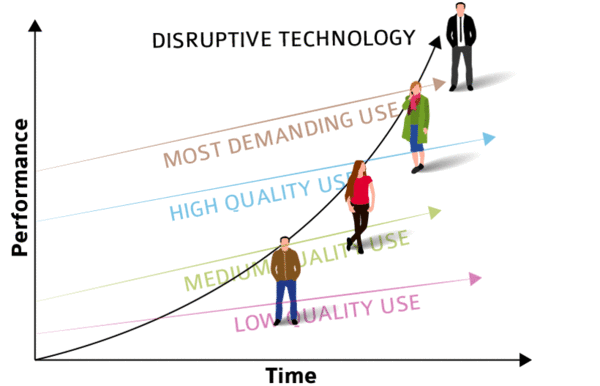Disruptive business model
| Disruptive business model |
|---|
| See also |
Due to the high opportunities in the development of new technologies, more frequently these innovations establish the new markets. Such an event always has the consequences and usually it can be seen in the change of market share and customer preferences in the specific economical sector or industry. This new innovations are called the disruptive inventions, which by their nature disrupt other businesses and create a powerful competition. Currently, there are two main strategies for the companies and corporations. Either the company has to work on their main product and improve it, or the other choice is to innovate and create something new and different from what they have. However the main issue of innovating is investments, risks and fears. Many companies these days concentrate more on the risk management rather on the innovating processes (Clayton M. Christensen, McDonald R., Raynor M., 2015). The CEO fear to change the system, which works and makes profits. This strategy is working until your competitor invents the disruptive business model, after the invention of such a technology keep operating as before is a perfect recipe for disaster. Therefore, the innovation process has to be present in every business, if it wants to survive in the era of development and changes.
Disruptive business models
There are specific features for every business model and for understanding the disruptive business model, I have decided to start with the meaning of disruption, which already includes the first feature in the definition. Disruption means breaking away from the old, what means the disruptive innovation is creating a new market, which was not existed before, or creating a new values and propositions (Rogers D., n.d). The second symptom of such a model is that disruptive innovations don't catch on with mainstream customers until quality hits to their standards. Also, it is usually misleading that disruption innovation is a product; however, it is not like this. Disruptive innovation is a process of evolving and improvement of the invented product.
For instance, when the first electric cars were created, nobody thought of them, as of disruptive invention, because they simply did not meet the minimum customer requirements. The studies had showed that the main points, which were considered by the customers before the purchase of the automobile, were the acceleration, minimum cruising range and the possibility to be personalized (Clayton M. Christensen, 1997). The electric cars were losing by all these factors; however, nobody took to a consideration the fact that the technology is moving ahead at a faster rate than the market's trajectory of needs. This situation was happening in 1990s, and now after more than 28 years, the electric cars are in the demand and are valued as a privilege by the customers due to the cost of purchase and the convenience.
The summary of the main theoretical features of the disruptive business models
- Disruptive business models start as start-ups, which launch their product on the low quality customers and improve their products with the time, gaining the market share, challenging and disrupting the incumbent. By incumbent, I mean the established business, which is operating on the large scale with the mainstream customers.
- Disruptive product is the one, which opens the new features on the market for customers and supply's people with unique product. The product or service that was moderated, improved cannot be disruptive, as it remains the market offer and it is main features. Therefore, it is significant not to be miss leaded and misguided, when identifying the business model.
- Innovation is not a result; it is the process, which is followed by the failures and constant attempts.
References
- Clayton M. Christensen, 1997, The innovator’s dilemma: when new technologies cause great firms to fail, Harvard Business School Press, Boston, Massachusetts.
- Clayton M. Christensen, McDonald R., Raynor M., 2015, What Is Disruptive Innovation?, [online], accessed 16th of December
- Hübner S., 2018, Beyond the Buzzword: Disruptive Innovation Explained, [online], accessed 20th of December
- Rogers D., n.d, Mastering Disruptive Business Models, [online], accessed 16th of December
